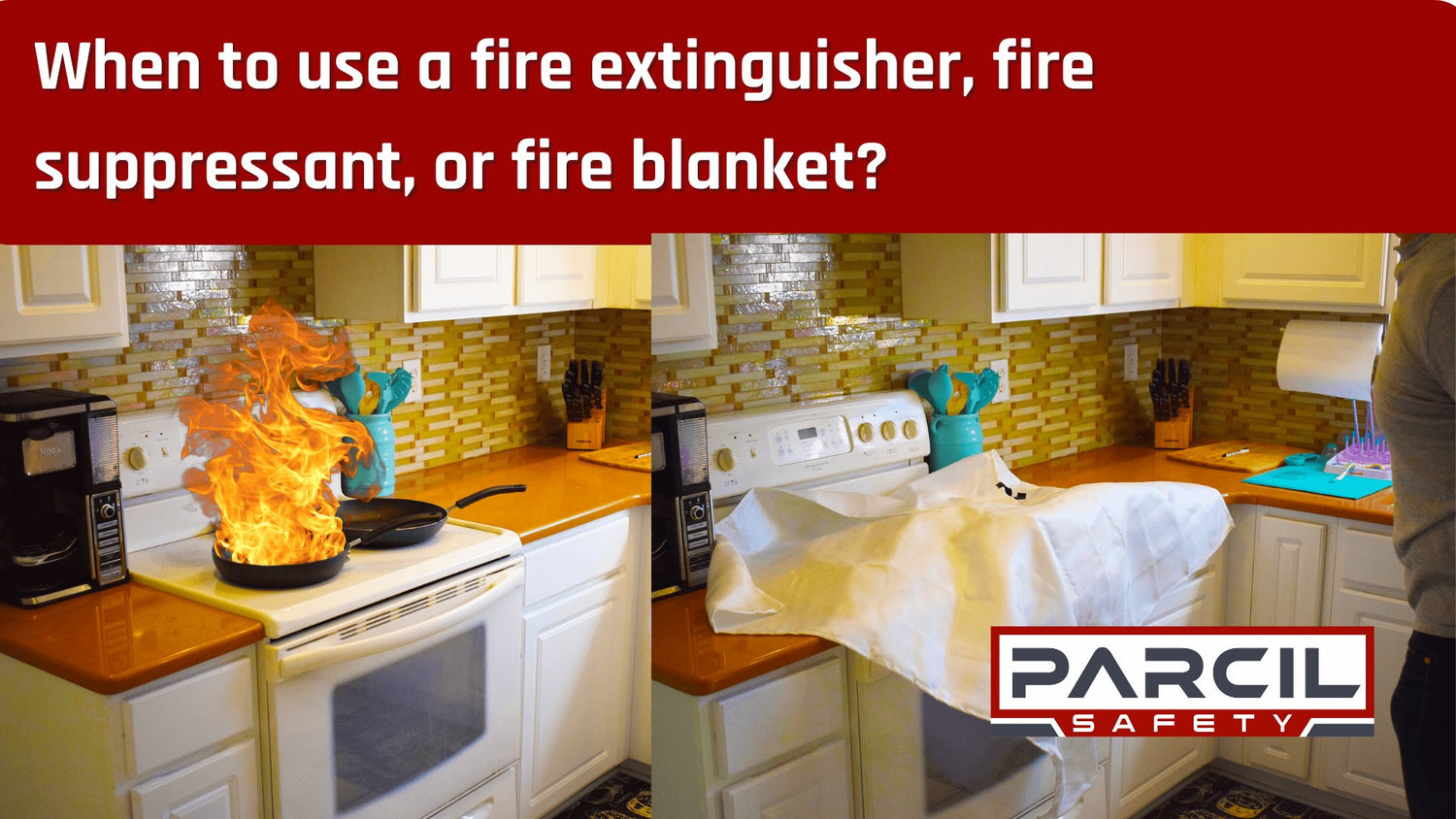What are the differences between fire extinguishers, fire suppressants and fire blankets?
Most people know that fire extinguishers are used to put out a fire, but have you ever considered using a fire suppressant for fire blanket, instead? There are several differences between fire extinguishers, fire suppressants, and fire blankets. Below we discuss these differences and when you should use each type of fire safety product.
What is a fire extinguisher?
A fire extinguisher is a portable device that is used to extinguish small fires or to contain them until the fire department arrives. Fire extinguishers typically contain a pressurized substance that is released when the handle is squeezed. The substance can be in the form of a liquid, powder, or gas, depending on the type of extinguisher. When used correctly, a fire extinguisher can quickly put out a small fire or prevent it from spreading. Fire extinguishers are commonly found in public places, such as offices, schools, and hotels, as well as in homes and vehicles. It is important to know how to use a fire extinguisher properly in case of an emergency.
When should I use a fire extinguisher?
There are actually several different kinds of fire extinguishers you can use, depending on how the fire got started. Below are some examples of when to use some more common types of fire extinguishers:- Water fire extinguishers: These are used to extinguish fires caused by materials such as paper, cardboard, and wood.
- Foam fire extinguishers: These are used to extinguish fires caused by flammable liquids, such as gasoline, oil, and cooking oil.
- CO2 fire extinguishers: These are used to extinguish fires caused by electrical equipment and flammable liquids.
- Dry chemical fire extinguishers: These are used to extinguish fires caused by flammable liquids and gases.
- Wet chemical fire extinguishers: These are used to extinguish fires caused by cooking oils and fats.
What is a fire suppressant?
A fire suppressant is a substance or system that is designed to control or extinguish fires. Fire suppressants are typically used in larger buildings, such as commercial and industrial facilities, and are often integrated into the building's fire protection system. The type of fire suppressant used will depend on the type of fire hazard that is present.
Examples of fire suppressants include water-based systems, which may use sprinklers or misting nozzles to control a fire, and chemical-based systems, such as foam or dry chemical systems, which are often used to control fires involving flammable liquids. Some facilities may also use gaseous fire suppression systems, which use agents like carbon dioxide, halon, or FM200 to displace oxygen and extinguish a fire. Fire suppressants are an important part of fire safety systems and can help prevent property damage, injuries, and loss of life in the event of a fire.
When should I use a fire suppressant?
Similar to fire extinguishers, fire suppressants come in multiple forms. Below are some examples and when to use each:
- Halon fire suppressants: These are used in areas with sensitive equipment, such as computer rooms and laboratories.
- Clean agent fire suppressants: These are used in areas with sensitive equipment where water or foam may cause damage.
- Carbon dioxide (CO2) fire suppressants: These are used in areas with electrical equipment.
- Foam fire suppressants: These are used in areas where flammable liquids may be present.
What is a fire blanket?
A fire blanket is a safety device that is used to smother small fires or to wrap around a person whose clothing is on fire. Fire blankets are made from fire-resistant materials, such as fiberglass, wool, or Kevlar, and are designed to resist burning, melting, or shrinking when exposed to high temperatures.
To use a fire blanket, the blanket is quickly pulled out of its container and placed over the fire or around the person whose clothing is on fire. The blanket should be held in place for a few seconds to ensure that the fire is extinguished or until help arrives. Fire blankets are commonly used in kitchens, laboratories, and other areas where small fires may occur. They are also useful in situations where water or other extinguishing agents may not be appropriate, such as with electrical fires or in areas with sensitive equipment. Fire blankets are an effective and versatile tool for fire safety and should be included in any fire safety plan.
When should you use a fire blanket?
There are three main kinds of Fire Blankets – Fiberglass fire blankets, wool fire blankets, and silicone coated fire blankets. Below we discuss when to use each.- Fiberglass fire blankets: These are used to smother small fires in a kitchen or other small work areas. Because fiberglass fire blankets are used to smother out small fires and doesn’t use any chemicals, it is ideal for chemical based fires, oil-based fires, or anything where water or standard fire extinguishers can’t extinguish.
- Wool fire blankets: These are used to smother larger fires in a larger area. Typically you will see these being used in large industrial settings, wildfire settings, or any large work area.
- Silica fire blankets: These are used to smother fires caused by welding or cutting, and are also great for wrapping around the body, as the silicone coat protects the user from receiving fiberglass splinters. You will typically find these as standard rectangular blankets or somethings they’ve been fashioned in to cloaks purposely designed to be worn if you are trying to exit a fire or put fire out on someone’s clothing.
Check out Parcil Safety's Fire Blanket Selection!
PD-452 Fiberglass Fire Extinguisher Blanket
SHOP NOW |
SB-500 Silicone Coated Fire Emergency Blanket
SHOP NOW |
FEC-100 Silicone Coated Fire Escape Cloak
SHOP NOW |


























Leave a comment
All comments are moderated before being published.
This site is protected by hCaptcha and the hCaptcha Privacy Policy and Terms of Service apply.